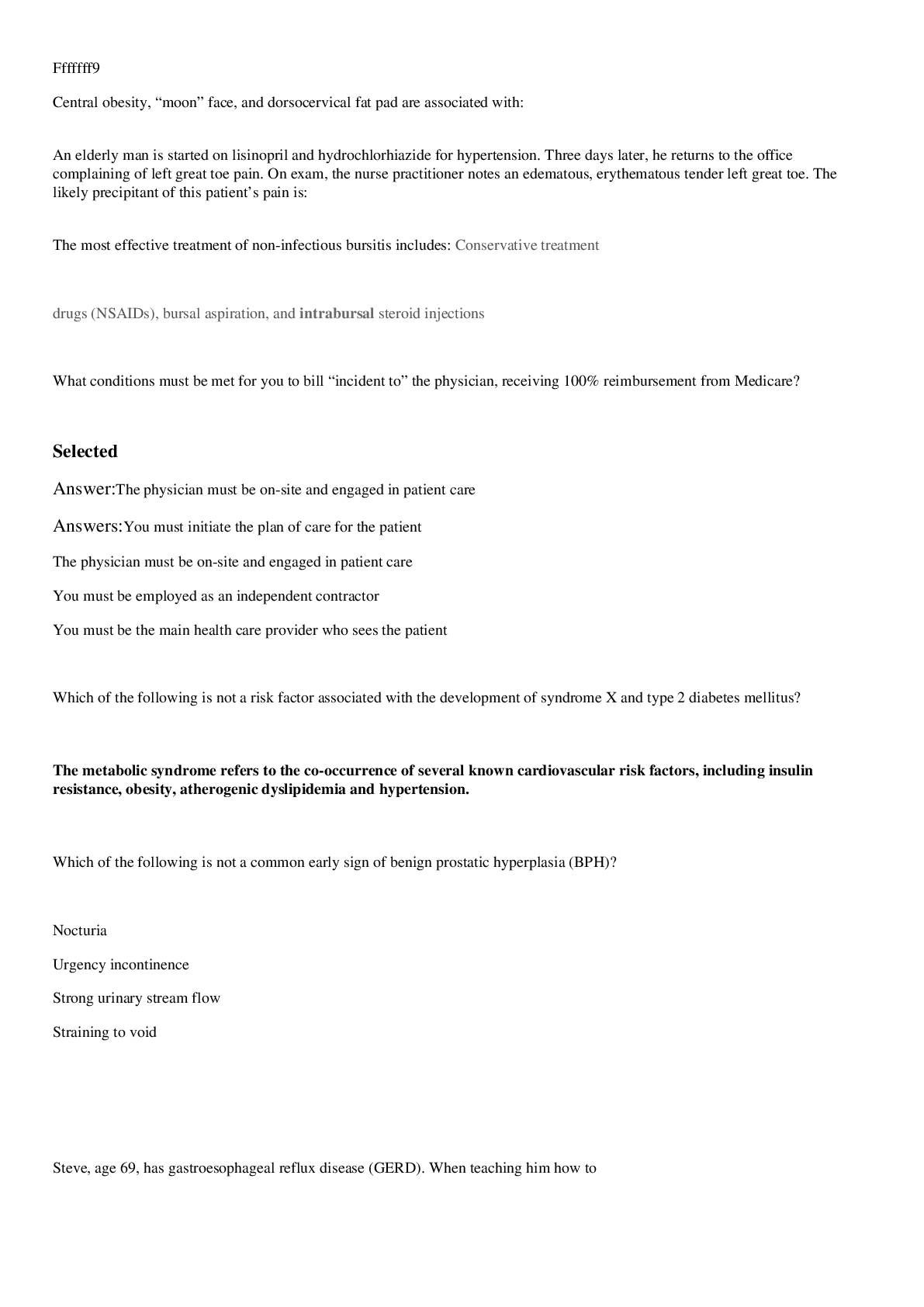*NURSING > EXAM > Walden University; NURSING 6531 final exam 1 (Microsoft.com Account Team)-VERIFIED AND RELIABLE EXAM (All)
Question 2 1 out of 1 points Central obesity, “moon” face, and dorsocervical fat pad are associated with: A . Metabolic syndrome B . Unilateral pheochromocytoma C . Cushing’s syndrome ... D . None of the above Question 3 1 out of 1 points An elderly man is started on lisinopril and hydrochlorhiazide for hypertension. Three days later, he returns to the office complaining of left great toe pain. On exam, the nurse practitioner notes an edematous, erythematous tender left great toe. The likely precipitant of this patient’s pain is: A . Trauma B . Tight shoes C . Arthritis flare D . Hydrochlorothiazide Question 4 1 out of 1 points The most effective treatment of non-infectious bursitis includes: Conservative treatmentincludes rest, cold and heat treatments, elevation, administration of nonsteroidal anti-inflammatory drugs (NSAIDs), bursal aspiration, and intrabursal steroid injections Question 5 1 out of 1 points What conditions must be met for you to bill “incident to” the physician, receiving 100% reimbursement from Medicare? Selected Answer: The physician must be on-site and engaged in patient care Answers: You must initiate the plan of care for the patient The physician must be on-site and engaged in patient care You must be employed as an independent contractor You must be the main health care provider who sees the patient Question 6 1 out of 1 points Which of the following is not a risk factor associated with the development of syndrome X and type 2 diabetes mellitus? The metabolic syndrome refers to the co-occurrence of several known cardiovascular risk factors, including insulin resistance, obesity, atherogenic dyslipidemia and hypertension. Question 7 1 out of 1 points Which of the following is not a common early sign of benign prostatic hyperplasia (BPH)? A. Nocturia B. Urgency incontinence C. Strong urinary stream flow D. Straining to void [Show More]
Last updated: 3 years ago
Preview 1 out of 37 pages

Buy this document to get the full access instantly
Instant Download Access after purchase
Buy NowInstant download
We Accept:


NURS 6531 Final Exam (3 Versions), NURS 6531 Midterm Exam (3 Versions): (100 Q & A in Each Version) & NURS 6531 Week 1, 2, 4, 6, 7, 9, 11 Quiz: Walden University |2021/2022|
By d.occ 4 years ago
$45
12
Can't find what you want? Try our AI powered Search
Connected school, study & course
About the document
Uploaded On
May 12, 2021
Number of pages
37
Written in
All
This document has been written for:
Uploaded
May 12, 2021
Downloads
0
Views
130
Scholarfriends.com Online Platform by Browsegrades Inc. 651N South Broad St, Middletown DE. United States.
We're available through e-mail, Twitter, Facebook, and live chat.
FAQ
Questions? Leave a message!
Copyright © Scholarfriends · High quality services·